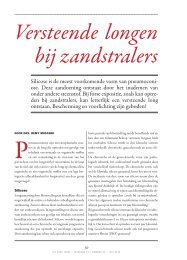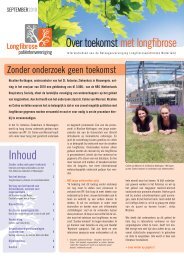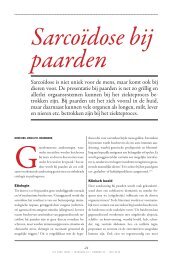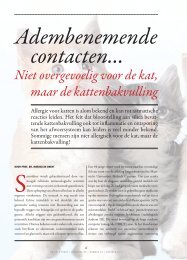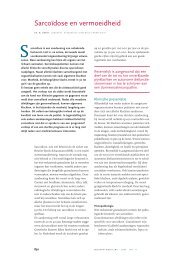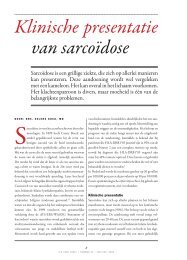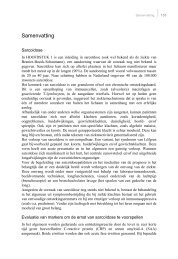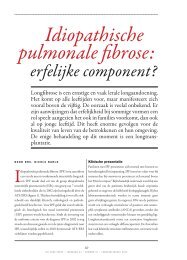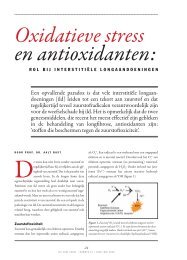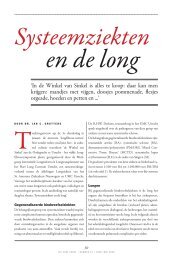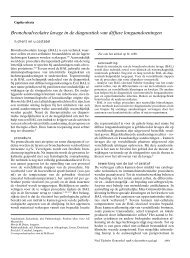Interpretation of bronchoalveolar lavage fluid cytology - ILD care
Interpretation of bronchoalveolar lavage fluid cytology - ILD care
Interpretation of bronchoalveolar lavage fluid cytology - ILD care
You also want an ePaper? Increase the reach of your titles
YUMPU automatically turns print PDFs into web optimized ePapers that Google loves.
<strong>Interpretation</strong> <strong>of</strong> BALF <strong>cytology</strong><br />
(Group II). If the distinction turns out to be in favour <strong>of</strong> non-infectious lung disease, in the second step, the already<br />
validated logistic regression model can be used for distinguishing between the three non-infectious <strong>ILD</strong>:<br />
sarcoidosis, IPF and EAA [9].<br />
Results<br />
The characteristics and BALF analysis results <strong>of</strong> the Group I (10) and Group II [8,9] were reported previously. These<br />
data are summarized in table 1. In contrast to what was found in the subpopulations <strong>of</strong> Group II, in Group I no<br />
significant difference was demonstrated between smokers and non-smokers [10].<br />
Table 1.-BALFvariables from the studied subpopulations used in the polychotomous regression model<br />
Study groups (n)<br />
Sar (Nsm) (145)<br />
Sar (Sm) (45)<br />
EEA (Nsm) (34)<br />
EAA (Sm) (4)<br />
IPF (Nsm) (27)<br />
IPF (Sm) (17)<br />
Infectious (31)<br />
(Nsm+Sm)<br />
Yield,% TCCx10 4 .mL -1 AMs*<br />
55.6±1.0<br />
(20.0-85.0)<br />
56.6±1.6<br />
(22.5-82.5)<br />
46.4±1.8<br />
(25.0-67.5)<br />
43.4±4.6<br />
(31.0-52.5)<br />
42.6±2.4<br />
(12.5-65.0)<br />
46.1±4.2<br />
(30.0-70.0)<br />
28.9±5.1<br />
(7.5-67.5)<br />
18.9±10.0<br />
(3.6-63.0)<br />
31.5±23.9<br />
(6.4-167.1)<br />
41.7±25.6<br />
(3.4-110.9)<br />
54.6±34.6<br />
(30.0-105.7)<br />
24.2±29.5<br />
(5.5-168.8)<br />
51.9±25.2<br />
(5.5-168.8)<br />
329.1±84.8<br />
(7-2432)<br />
63.2±1.5<br />
(18.1-98.0)<br />
74.9±2.5<br />
(33.0-98.8)<br />
38.2±1.5<br />
(5.2-75.1)<br />
57.3±5.6<br />
(41.1-72.8)<br />
67.8±3.7<br />
(44.8-91.7)<br />
63.3± 8.5<br />
(8.1-88.8)<br />
7.0±1.3<br />
(0-25.0 )<br />
PMNs* Lym* Eos*<br />
1.7± 0.4<br />
(0-64.0)<br />
1.2± 0.2<br />
(0-4.8)<br />
4.3±0.6<br />
(0.2-12.4)<br />
5.8±1.2<br />
(2.6-8.0)<br />
11.7±1.9<br />
(0.9-39.5)<br />
18.9± 8.9<br />
(0.2-89.6)<br />
90.5±1.5<br />
(68.8-99.8)<br />
34.5±1.5<br />
(0.9-80.2)<br />
23.0±1.8<br />
(0-67.0)<br />
58.1±2.6<br />
(14.6-83.2)<br />
40.8±7.5<br />
(19.8-53.9)<br />
13.8±3.0<br />
(0.9-43.6)<br />
10.2±2.7<br />
(0.1-20.0)<br />
1.9±0.5<br />
(0-10.8)<br />
0.55±0.1<br />
(0-5.0)<br />
0.7±0.2<br />
(0-5.1)<br />
2.6±0.5<br />
(0-14.3)<br />
3.3±2.3<br />
(0.5-10.3)<br />
6.4 ±1.8<br />
(0-38.6)<br />
7.6±2.8<br />
(0.3-48.2)<br />
0.04±0.3<br />
(0-0.8)<br />
Data are expressed as mean ± standard error <strong>of</strong> the mean (SEM) and range in parentheses. Definition <strong>of</strong> abbreviations:<br />
n=number <strong>of</strong> cases; TCC=total cell count; AMs=alveolar macrophages; PMNs= polymorphonuclear neutrophils;<br />
Lym=lymphocytes; Eos=eosinophils; Sar=sarcoidosis; EAA=extrinsic allergic alveolitis; IPF=idiopathic pulmonary fibrosis;<br />
NSm=nonsmokers; Sm=smokers. *percentages <strong>of</strong> the total cell count<br />
he explanatory variables derived from BALF used in this study for distinguishing pulmonary diseases <strong>of</strong> infectious<br />
and non-infectious origin were: yield or recovery ((out/in) x 100% <strong>of</strong> the BALF), total cell count (TCC) x 10 4 .mL -1 , the<br />
percentages <strong>of</strong> eosinophils, polymorphonuclear neutrophils (PMNs), lymphocytes and alveolar macrophages,<br />
respectively. These variables were non-missing for 31 subjects with a pulmonary disorder <strong>of</strong> a bacterial infectious<br />
origin (Group I) and 272 subjects with non-infectious <strong>ILD</strong> (Group II). Univariate testing (using the Mann-Whitney test)<br />
showed significant differences between both groups <strong>of</strong> patients for each <strong>of</strong> these variables separately (p



